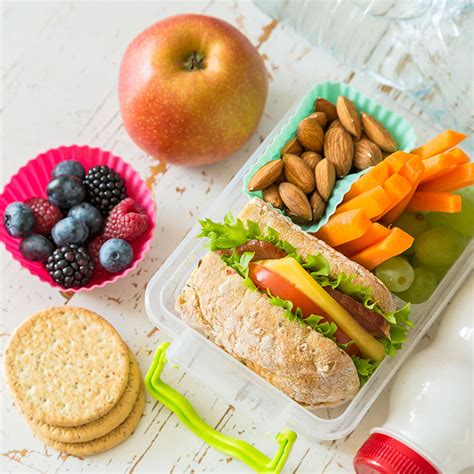Introduction
Fueling your body with nutritious snacks is crucial for students to stay energized, focused, and ready to learn throughout the school day. Ditch the sugary treats and processed snacks that can leave you feeling sluggish and opt for healthy options that will keep you going strong.

According to the Centers for Disease Control and Prevention (CDC), nearly 30% of children in the United States are overweight or obese. Eating habits established during the school years can have a lasting impact on health, making it essential to promote healthy snacking choices.
Pain Points of Unhealthy Snacking
Unhealthy snacks can lead to a range of problems for students:
- Poor academic performance: Studies have shown that a high-fat diet can impair cognitive function and memory.
- Increased risk of chronic diseases: Consuming excessive sugar and unhealthy fats can contribute to obesity, heart disease, and type 2 diabetes.
- Sluggishness and fatigue: Processed snacks often provide a quick energy boost but leave you feeling tired and hungry shortly afterward.
- Stomach problems: Sugary and acidic snacks can cause stomach upset, indigestion, and bloating.
Motivation for Healthy Snacking
Opting for healthy snacks offers numerous benefits:
- Enhanced cognitive function: Fruits, vegetables, and whole grains provide nutrients that support brain health and improve cognitive abilities.
- Improved mood: Healthy snacks can help stabilize blood sugar levels, reducing mood swings and irritability.
- Boosted energy levels: Complex carbohydrates and healthy fats provide sustained energy that will keep you going all day long.
- Reduced risk of disease: Fruits, vegetables, and fiber-rich foods are packed with antioxidants and other protective nutrients that reduce the risk of chronic diseases.
Common Mistakes to Avoid
When choosing healthy snacks, avoid these common pitfalls:
- Overestimating portion sizes: Even healthy snacks can be high in calories if you eat too much. Pack snacks in individual portions to prevent overeating.
- Choosing packaged “healthy” options: Processed snacks often use misleading labeling tricks to appear healthy. Read food labels carefully and choose snacks with minimal added sugar, salt, and preservatives.
- Not planning ahead: Failing to pack snacks can lead to impulsive unhealthy choices when hunger strikes. Plan your snacks the night before or during the weekend to avoid this trap.
- Ignoring food intolerances: If you have any food intolerances, be sure to choose snacks that are safe for you.
Why Healthy Snacks Matter for Students
Healthy snacks play a crucial role in student success:
- Improved attention and focus: Eating a nutritious snack before a test or class can boost cognitive function and help you perform better.
- Enhanced academic performance: A study published in the journal “Pediatrics” found that children who ate a healthy breakfast and lunch scored higher on standardized tests.
- Reduced absenteeism: Students who eat healthy snacks throughout the day are less likely to get sick, resulting in fewer absences.
- Healthy habits for life: Establishing healthy snacking habits in school can lay the foundation for a lifetime of healthy eating choices.
How to Prepare Healthy Snacks
Preparing healthy snacks for school is easy and convenient:
- Wash and cut fruits and vegetables: Fruits and vegetables are packed with nutrients and fiber, making them ideal snacks. Wash and cut them ahead of time to make them easy to grab and go.
- Make homemade snacks: Baking your own snacks allows you to control the ingredients and keep them free of preservatives and added sugar. Consider making granola bars, fruit leather, or trail mix.
- Pack leftovers: Leftover meals from dinner can make great snacks. Pack healthy options like salads, sandwiches, or soup.
- Purchase pre-packaged healthy snacks: There are many healthy pre-packaged snacks available at most grocery stores. Look for options with minimal added sugar and salt.
Creative Snack Ideas
Looking for some inspiration? Here are some creative snack ideas that are both healthy and delicious:
- Fruit and nut skewers: Thread berries, bananas, and cubes of cheese onto skewers for a colorful and nutritious snack.
- Veggie sticks and hummus: Cut up carrots, celery, and cucumbers into sticks and serve them with a side of hummus for a fiber-packed snack.
- Air-popped popcorn with nutritional yeast: Air-popped popcorn is a whole-grain snack that can be seasoned with nutritional yeast for added protein and flavor.
- Yogurt parfaits: Layer yogurt, granola, and fruit in a parfait glass for a creamy and satisfying snack.
Nutritious Snack Table
| Snack | Calories | Protein (g) | Fiber (g) |
|---|---|---|---|
| Apple slices with peanut butter | 150 | 5 | 5 |
| Banana with almond butter | 200 | 10 | 6 |
| Veggie sticks with hummus | 200 | 6 | 10 |
| Trail mix with nuts, seeds, and dried fruit | 250 | 10 | 15 |
| Yogurt parfait | 300 | 20 | 10 |
| Air-popped popcorn with nutritional yeast | 250 | 10 | 12 |
Beneficial Snack Table
| Snack | Benefits |
|---|---|
| Fruits | Rich in vitamins, minerals, and antioxidants |
| Vegetables | High in fiber, vitamins, and minerals |
| Whole grains | Provide sustained energy and fiber |
| Nuts and seeds | Packed with protein, healthy fats, and fiber |
| Yogurt | Provides protein, calcium, and probiotics |
Food Intolerance Snack Table
| Food Intolerance | Safe Snack Options |
|---|---|
| Gluten | Fruits, vegetables, rice, potatoes, quinoa |
| Dairy | Fruits, vegetables, nuts, seeds, tofu |
| Lactose | Fruits, vegetables, meat, fish, poultry |
| Soy | Fruits, vegetables, rice, potatoes, eggs |
| Nuts | Fruits, vegetables, yogurt, cheese |
